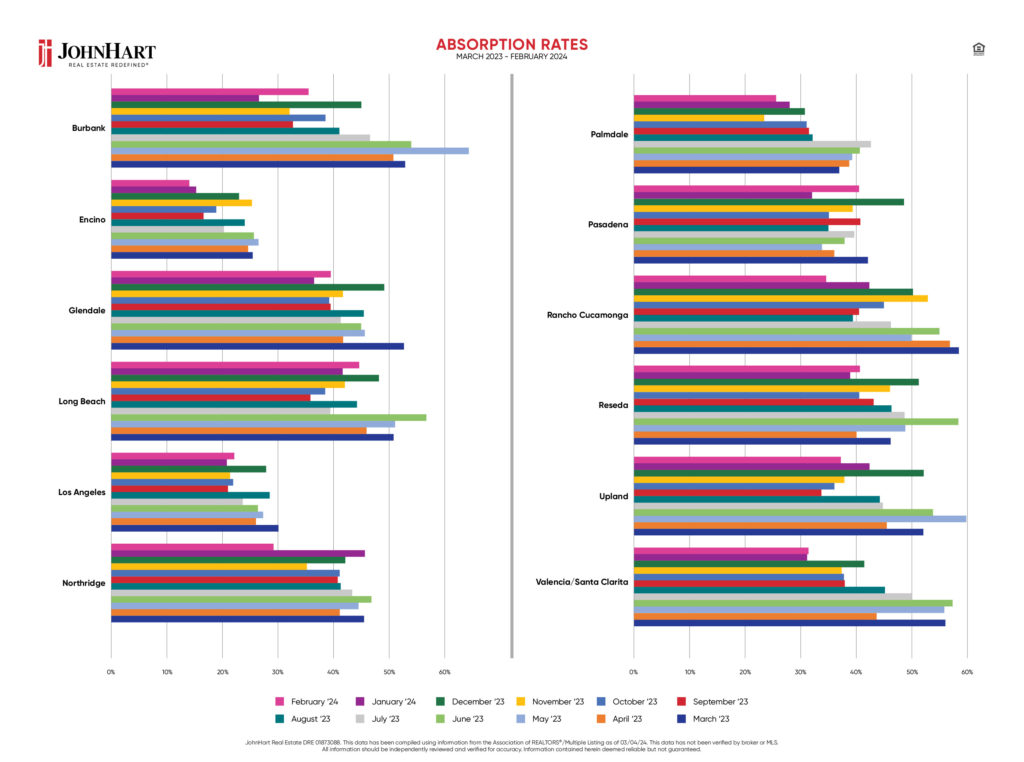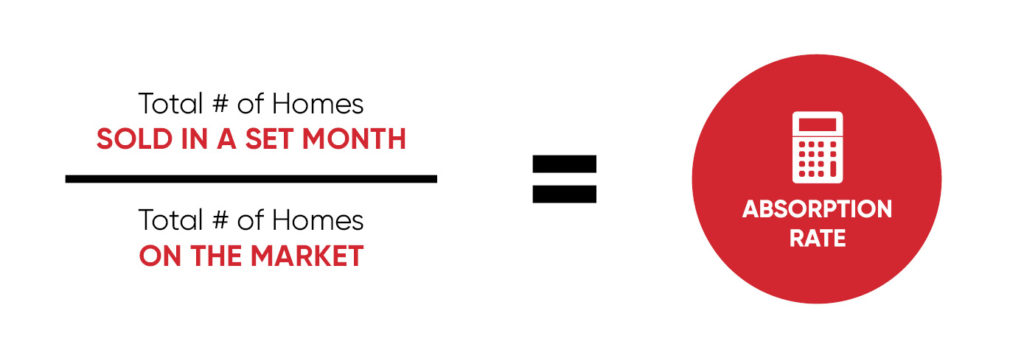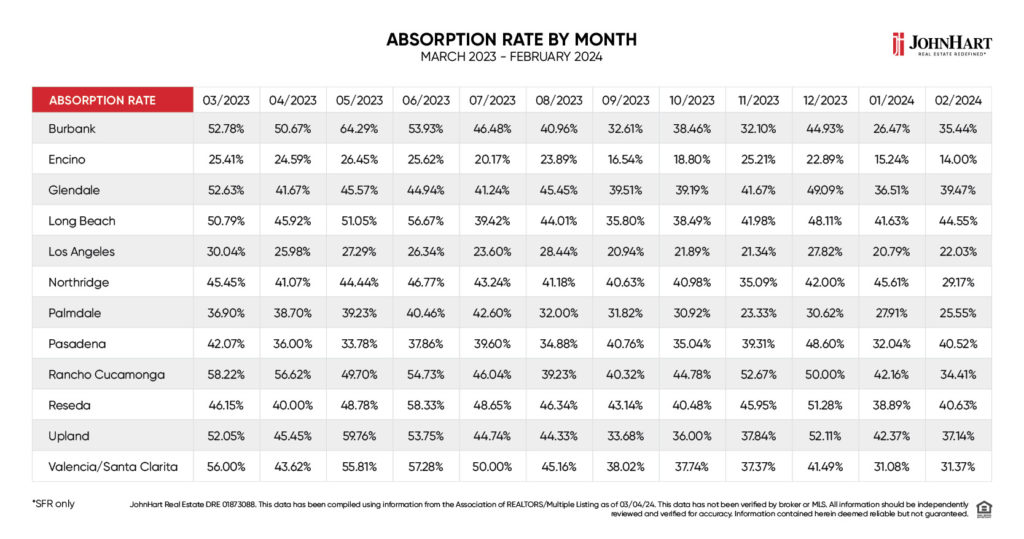February’s come and gone and we have to say it wasn’t quite the expected mad dash deeper into seller’s territory. Typically, when we see a nearly unanimous drop toward the buyer’s favor like what we witnessed in January, it’s just the beginning of the slingshot being pulled back. The next month is almost always a severe snap in the opposite direction. And while half of our neighborhoods did an about-face march, returning toward the seller’s favor, only two neighborhoods did so with any real extremity. And those neighborhoods are hardly a surprise. Perhaps more interestingly, January’s holdout, the one neighborhood that refused to budge toward buyers’ relief, is making up for lost time in February with the biggest drop. If you’ve been here before, skip the FAQs and head straight to the good stuff below.
Absorption Rate FAQs
What is an absorption rate?
An absorption rate is a statistic that we use in the real estate industry. It’s purpose? To help us gauge whether a particular neighborhood is in a buyer’s market or a seller’s market. Absorption rates exceeding 20% generally indicate a market that favors sellers. Those at 15% or below are generally believed to favor the buyer. That’s a lot of “generally.” But as any real estate agent in the Los Angeles area can tell you, the absorption rate is more of a guide than a rule.
JohnHart only factors single-family homes into its absorption rate calculations. Why?
Our research has shown that JohnHart’s clients have an overwhelming interest in single-family homes. Therefore, we don’t consider townhouses or condos in our absorption rate figures. It’s all about creating an accurate picture as dictated by our clients’ interests.
How does JohnHart calculate an absorption rate for a given neighborhood?
To calculate absorption rates, we use the following universal formula:
A Leisurely Jaunt Further Into the Seller’s Favor
As we mentioned, half of the neighborhoods for which we publish absorption rate data did heel-turns in February to march back toward the seller’s favor. To be fair, these neighborhoods were already firmly in the seller’s market, even after the plummets in January. Well, all except for Los Angeles proper which bumped upward just a single percentage point for a 22% absorption rate in February.
The two biggest surges of the month shouldn’t come as a shock. The always-popular neighborhoods of Burbank and Pasadena jumped up 9 percentage points each for 35% and 41% absorption rates respectively. Seeing Burbank drop down to a 26% absorption rate gave us a rare thrill in January. But after that 19 percentage point drop, we expected an even more dramatic surge from a neighborhood that tends to always smile on the seller.
The same goes for Pasadena’s 9 percentage point rebound after the neighborhood’s steep 17 percentage point plunge in January. We have no doubt these cities are climbing back to a very solid seller’s favor. They’re just taking a longer road than we expected.
Long Beach Returns to the Top Spot
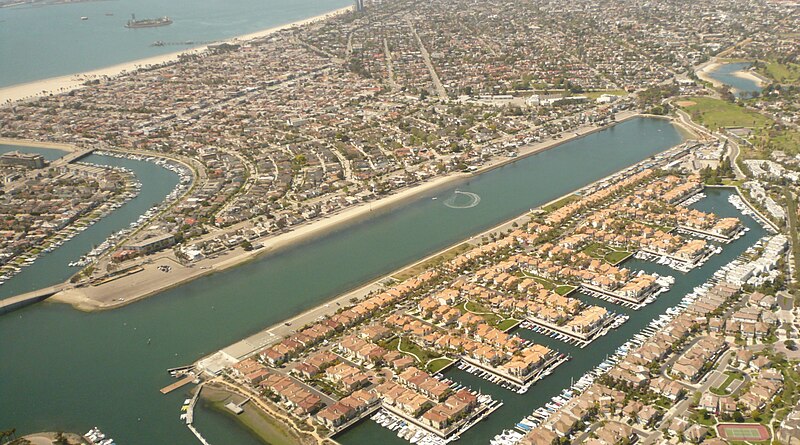
Yet, neither Burbank nor Pasadena was able to claim the highest absorption rate for February. That distinction goes to another neighborhood that consistently favors sellers: Long Beach. With a hop of only 3 percentage points, Long Beach secures a very solid seller’s favor at a 45% absorption rate.
This isn’t even close to a high for the community. Remember last June when Long Beach climbed to a 57% absorption rate? So, if February’s numbers are discouraging you from finding that perfect Long Beach home, we recommend you keep searching. Your competitors certainly will be!
Northridge Stands Out Again
The big news in February’s plummets toward the buyer’s favor no doubt belongs to Northridge. In January, this was the rebel community; the one that refused to drop when every other neighborhood did. Well, Northridge compensated for January’s resistance with a drop that dwarfs all others in February.
Plunging a stunning 17 percentage points, Northridge ended February with a 29% absorption rate. That may seem high, but for anyone who’s been following us a while, you’ll recognize Northridge hasn’t been this low since November 2022. Buyers take note!
How Low Can Encino Go?
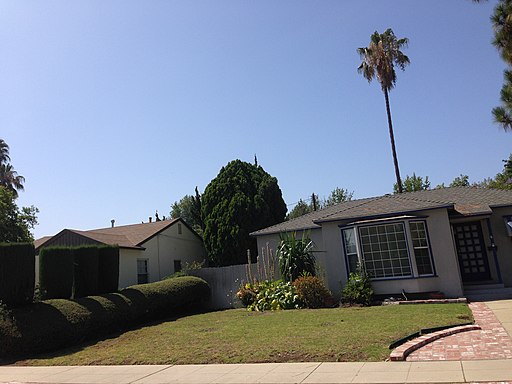
Not to let Northridge steal Encino’s thunder. The lowest absorption rate for February easily went to Encino, which dropped a single percentage point into the buyer’s territory. Yes, officially the buyer’s territory!
Encino flirted with the buyer’s market in January with a 15% absorption rate but doubled down in February with a 14% absorption rate. It may surprise you that this isn’t a low for Encino. But, to be fair, we haven’t seen them hitting these depths in over a year.
The Course Forward… or Backward
So, February might not have been as easy on the buyers as January. But it wasn’t exactly the seller’s revenge we’d envisioned. Could the housing market finally be stabilizing into something a bit more practical for both sides? We wouldn’t hold our breath, but stranger things have happened. This is Southern California, after all! While we wait to see what March brings, start working out your real estate game plan with one of our talented agents today!


